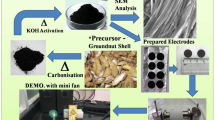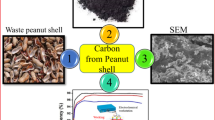Abstract
The energy demands of the world have been accelerating drastically because of the technological development, population growth and changing in living conditions for a couple of decades. A number of different techniques, such as batteries and capacitors, were developed in the past to meet the demands, but the gap, especially in energy storage, has been increasing substantially. Among the other energy storage devices, supercapacitors have been advancing rapidly to fill the gap between conventional capacitors and rechargeable batteries. In this study, natural resources such as pistachio and acorn shells were used to produce the activated carbons for electrode applications in a supercapacitor (or an electrical double-layer capacitor—EDLC). The activated carbon was synthesized at two different temperatures of 700 °C and 900 °C to study its effect on porosity and performance in the supercapacitor. The morphology of the activated carbon was studied using scanning electron microscopy (SEM). A solution of tetraethylammonium tetrafluoroborate (TEABF4)/propylene carbonate (PC) was prepared to utilize in supercapacitor manufacturing. The performance of the EDLC was investigated using cyclic voltammetry (CV) and electrochemical impedance spectroscopy. Activated carbons from both the pistachio and acorn shells synthesized at 700 °C in argon gas for two hours exhibited better surface textures and porosity. There activated carbons also exhibited more capacitor-like behavior and lower real impedances, indicating that they would have superior performance compared to the activated carbons obtained at 900 °C. This study may be used to integrate some of natural resources into high-tech energy storage applications for sustainable developments.












Similar content being viewed by others
References
Bingbing W, Zhongdong Y, Xiangning X (2010) Super-capacitors energy storage system applied in the microgrid. In: Industrial electronics and applications (ICIEA), 2010 the 5th IEEE Conference on. IEEE, pp 1002–1005
Balducci A, Dugas R, Taberna P-L et al (2007) High temperature carbon–carbon supercapacitor using ionic liquid as electrolyte. J Power Sources 165:922–927
Du X, Wang C, Chen M, Jiao Y, Wang J (2009) Electrochemical performances of nanoparticle Fe3O4/activated carbon supercapacitor using KOH electrolyte solution. J Phys Chem C 113:2643–2646
Inal IIG, Gokce Y, Aktas Z (2016) Waste tea derived activated carbon/polyaniline composites as supercapacitor electrodes. In: Renewable energy research and applications (ICRERA), 2016 IEEE International Conference on. IEEE, pp 458–462
Chen Y, Zhang X, Zhang D, Yu P, Ma Y (2011) High performance supercapacitors based on reduced graphene oxide in aqueous and ionic liquid electrolytes. Carbon 49:573–580
Chen Y, Zhang X, Zhang D, Ma Y (2012) High power density of graphene-based supercapacitors in ionic liquid electrolytes. Mater Lett 68:475–477
Fan Z, Yan J, Wei T et al (2011) Asymmetric supercapacitors based on graphene/MnO2 and activated carbon nanofiber electrodes with high power and energy density. Adv Funct Mater 21:2366–2375
Gao F, Qu J, Zhao Z, Wang Z, Qiu J (2016) Nitrogen-doped activated carbon derived from prawn shells for high-performance supercapacitors. Electrochim Acta 190:1134–1141
Li Z, Xu Z, Tan X et al (2013) Mesoporous nitrogen-rich carbons derived from protein for ultra-high capacity battery anodes and supercapacitors. Energy Environ Sci 6:871–878
Liu D, Zhang W, Lin H, Li Y, Lu H, Wang Y (2016) A green technology for the preparation of high capacitance rice husk-based activated carbon. J Clean Prod 112:1190–1198
Teo EYL, Muniandy L, Ng E-P et al (2016) High surface area activated carbon from rice husk as a high performance supercapacitor electrode. Electrochim Acta 192:110–119
Le Van K, Thi TTL (2014) Activated carbon derived from rice husk by NaOH activation and its application in supercapacitor. Prog Nat Sci Mater Int 24:191–198
Zhi M, Yang F, Meng F, Li M, Manivannan A, Wu N (2014) Effects of pore structure on performance of an activated-carbon supercapacitor electrode recycled from scrap waste tires. ACS Sustain Chem Eng 2:1592–1598
Lewandowski A, Olejniczak A, Galinski M, Stepniak I (2010) Performance of carbon–carbon supercapacitors based on organic, aqueous and ionic liquid electrolytes. J Power Sources 195:5814–5819
Hwang JY, Li M, ElKady MF, Kaner RB (2017) Next-generation activated carbon supercapacitors: a simple step in electrode processing leads to remarkable gains in energy density. Adv Funct Mater 27:1605745
Faisal MSS (2015) Studying activated carbons of natural sources for supercapacitor applications. MS Thesis, Wichita State University
Faisal MSS, Rahman MM, Asmatulu R (2016) Investigating effectiveness of activated carbons of natural sources on various supercapacitors. In: Smart materials and nondestructive evaluation for energy systems 2016. International Society for Optics and Photonics, p 9
Choi JE, Ko S, Jeon YP (2019) Preparation of petroleum impregnating pitches from pyrolysis fuel oil using two-step heat treatments. Carbon Lett 29:369–376
(2015) Basics of electrochemical impedance spectroscopy Gamry instruments. Retrieved 2015. https://www.gamry.com/application-notes/EIS/
Jabbarnia A, Khan W, Ghazinezami A, Asmatulu R (2016) Tuning the ionic and dielectric properties of electrospun nanocomposite fibers for supercapacitor applications. Int J Eng Res Appl 6:65–73
Jabbarnia A, Khan WS, Ghazinezami A, Asmatulu R (2016) Investigating the thermal, mechanical, and electrochemical properties of PVdF/PVP nanofibrous membranes for supercapacitor applications. J Appl Polym Sci 133
Jabbarnia A, Asmatulu R (2015) Synthesis and characterization of PVdF/PVP-based electrospun membranes as separators for supercapacitor applications. J Mater Sci Technol Res 2:43–51
Baek J, Lee HM, An KH, Kim BJ (2019) Preparation and characterization of highly mesoporous activated short carbon fibers from Kenaf precursors. Carbon Lett 29:393–399
Acknowledgements
The authors gratefully acknowledge the Kansas NSF EPSCoR (#R51243/700333) and Wichita State University for the financial and technical support of this work.
Author information
Authors and Affiliations
Corresponding author
Additional information
Publisher's Note
Springer Nature remains neutral with regard to jurisdictional claims in published maps and institutional affiliations.
Rights and permissions
About this article
Cite this article
Faisal, M.S.S., Abedin, F. & Asmatulu, R. Activated carbons of pistachio and acorn shells for supercapacitor electrodes with TEABF4/PC solutions as electrolytes. Carbon Lett. 30, 509–520 (2020). https://doi.org/10.1007/s42823-020-00120-6
Received:
Revised:
Accepted:
Published:
Issue Date:
DOI: https://doi.org/10.1007/s42823-020-00120-6




